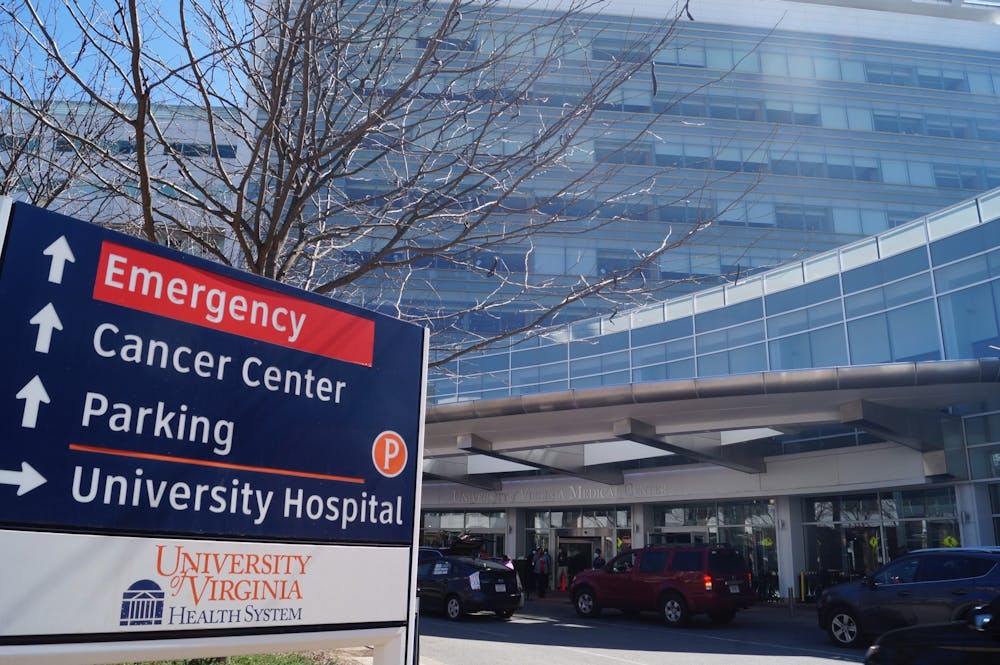Effective earlier this month, U.Va. Health has prohibited routine patient visitation with limited exceptions. Hospital lobbies and waiting rooms are also closed to visitation.
Sharon Bragg, assistant nurse manager of the intensive care unit at U.Va. Health, said patient visitation has been limited ever since COVID-19 patient numbers increased back in 2020. The policy has become even stricter in 2022.
“The decision comes down to the beds available in the hospital,” Bragg said.
As of January 29, 125 individuals are hospitalized for COVID-19 at U.Va. Health.
Bush Bell, administrator for hospitality and support services, said one of his roles in the hospital is to facilitate a group that meets every two weeks for the purpose of reviewing visitor status. The group consists of Bell, two physicians and Supply Chain Administrator Adam Momper, who looks at issues behind contracting in the hospital. The group’s goal is to create the right balance between allowing family support for both outpatients and inpatients and ensuring that everyone is safe.
“Restrictive visitation is not something we take lightly because there's research that says family in the hospital is beneficial [for recovery],” Bragg said.
In an email to The Cavalier Daily, Assoc. Nursing Prof. Jeanne Alhusen emphasized that the University healthcare community considers the change imperative to public safety.
“By limiting patient visitation, [the University Hospital staff] can further reduce the transmission of COVID-19 to patients currently receiving care as well as our employees who have contact with patients and our surrounding community members,” Alhusen said.
In the face of these conditions, technology has helped alleviate the isolation patients may feel.
“iPads for FaceTime and Webex [have been used] in order to connect families to their patients as much as they can during a pandemic, as well as using these means for base meetings with physicians and nurse practitioners,” Bragg said.
Bell said three factors determined the hospital’s decision to prohibit patient visitation — Blue Ridge Health District data, hospital census data and the number of COVID-19 patients in the intensive care unit.
The team first looked at the case numbers of COVID-19 within the greater Charlottesville community using the BRHD data. Over the last seven days, the daily average case level in Charlottesville is 105 new cases per day – while throughout November and mid-December, this same figure averaged about 8 new cases per day.
Bell’s team also analyzed the ratio between COVID-19 patients and non-COVID-19 patients— about 1 to 6 as of January 7 — within the hospital using the census data and found that the ratio was much higher than it was in November 2021 – about 1 to 22 on average.
As of January 26, 32 of the 78 patients in the ICU are COVID patients, the final figure that the team used to assign a risk level – low risk, limited risk, moderate risk or high risk. Whereas the hospital has been operating at moderate risk for the majority of 2021, this data analysis revealed that the level has now risen to high risk.
Because of these changes, patients’ family members are now only able to visit by exception. For example, pediatric patients are allowed a family member throughout their entire care whether they are inpatient or outpatient, and they may have two designated visitors but only one may be at the bedside at a time.
Another exception is made for patients who are reaching the end of their lives. These patients are allowed two designated visitors. Additionally, patients who are having a baby or who have cognitive or other significant disabilities are allowed one designated visitor to be with them for the entirety of their care. All exceptions were reviewed and approved by the hospital’s clinical team.
All visitors must be over the age of 18 and wear a mask at all times. They will be screened prior to entry. Food cannot be taken into ICU inpatient rooms, and large groups are not permitted to congregate. Visitors who have been tested positive for COVID-19, have symptoms of COVID-19, or have been exposed to a COVID-19 individual, are not permitted to visit until they have completed a 10-day quarantine and are 24-hours symptom free.
These exceptions apply mainly to non-COVID-19 patients. COVID-19 patients have even stricter visitor restrictions because of how contagious they are.
Bell estimated that it would take around three to four weeks from today for the peak of omicron to subside and for U.Va. Health to loosen patient visitation policies to reflect previous requirements.
“We recognized that this is a difficult decision, particularly for our patients and family members,” Alhusen said. “Yet, we understand that these types of decisions are necessary to protect the health of our patients and employees.”
In efforts to stay safe during this time, Bragg offers some advice for Charlottesville community members.
“Please get a COVID vaccination, wear a mask, be mindful of [your] own symptoms and try to not be around others if you have symptoms and get tested for COVID-19,” Bragg said.







